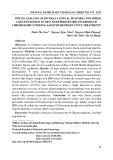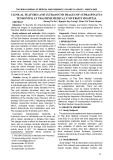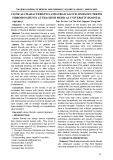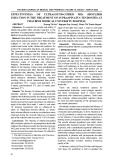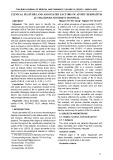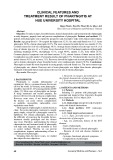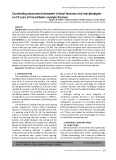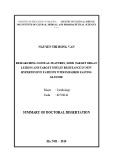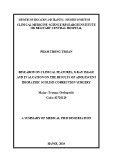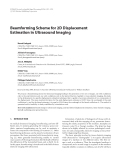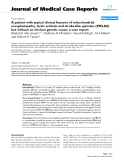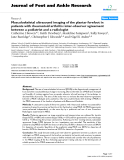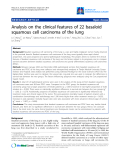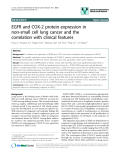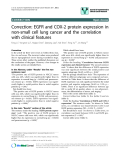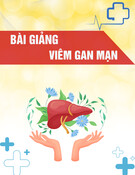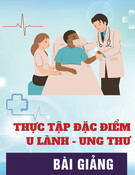
THAI BINH JOURNAL OF MEDICAL AND PHARMACY, VOLUME 16, ISSUE 2 - MARCH 2025
33
CLINICAL FEATURES AND ULTRASOUND IMAGES OF SUPRASPINATUS
TENDONITIS AT THAI BINH MEDICAL UNIVERSITY HOSPITAL
Duong Thi An1*, Nguyen Duy Cuong1, Pham Thi Thanh Huyen1
1. Thai Binh University of Medicine and Pharmacy
*Corresponding author: Duong Thi An
Email: Dr.anytb@gmail.com
Received date: 02/3/2025
Revised date: 20/3/2025
Accepted date: 23/3/20254
ABSTRACT
Objective: To describe the clinical features and
ultrasound images of supraspinatus tendonitis at
Thai Binh Medical University Hospital.
Study subjects and methods: Study subjects:
The study involved patients who had examinations
at Thai Binh Medical University Hospital and were
diagnosed with supraspinatus tendonitis based on
symptoms such as shoulder pain during abduction,
pain upon palpation of inferior and lateral point of
the acromial, a positive Jobe’s test. In addition,
ultrasound can show increased tendon thickness,
hypoechoic tendons, discontinuity of tendon
fibers, and tendon calcification. Study design: This
was a descriptive, cross-sectional survey. Pain
levels were assessed using the Visual Analog
Scale (VAS). Shoulder function was evaluated
using the Oxford Shoulder Score (OSS). OSS is
a questionnaire consisting of 12 questions, each
scored from 1 to 5, with a total score ranging from
12 (best) to 60 (worst).
Results: Among 34 patients with 35 shoulders
diagnosed with supraspinatus tendonitis, we found
that supraspinatus tendonitis was most common
in individuals aged 45 and older (97.1%). Females
were more affected than males (females 64.7%).
The right shoulder (dominant side) was more
commonly affected (70.6%). The average shoulder
abduction angle was 143.4 degrees. Functional
limitations of the shoulder were observed, with an
average OSS score of 46.7. Regarding ultrasound
findings, hypoechoic tendons were observed in
68.6%, increased tendon thickness in 28.6%,
tendon discontinuity and calcification were rare.
The average tendon thickness was 7.8mm.
Conclusion: Supraspinatus tendonitis is
commonly found in individuals over 45 years old,
with a higher prevalence in females than males.
The disease tends to affect the dominant shoulder
more, with an average shoulder abduction angle
of 143.4 degrees and an average OSS functional
activity score of 46.7. On ultrasound imaging,
supraspinatus tendinitis mainly presents as
hypoechoic changes and tendon thickening. The
average thickness of the supraspinatus tendon is
7.8 mm.
Keywords: Clinical features, ultrasound imag-
ing, supraspinatus tendonitis, Thai Binh Medical
University Hospital.
I. INTRODUCTION
Rotator cuff pathology is a common condition. The
incidence of symptomatic or asymptomatic rotator
cuff disease diagnosed by surgery or imaging
increases with age, from 9.7% in those under 20
years old to 62% in those over 80 [1]. In the general
population, rotator cuff disease is the most common
cause of shoulder pain. Any rotator cuff tendon can
be damaged, but the supraspinatus tendon is the
most frequently affected. The term “supraspinatus
tendon disease” refers to primary damage to the
supraspinatus tendon, including inflammation or
degeneration. This condition is also referred to as
“supraspinatus tendonitis.”
Currently, at Thai Binh Medical University
Hospital, shoulder pain is a common complaint,
with a significant number of cases being diagnosed
as supraspinatus tendonitis. There are also
other diagnoses, such as biceps tendonitis or
subacromial bursitis. To understand more about the
characteristics of supraspinatus tendonitis, thereby
supporting the diagnosis of the disease. Therefore,
we conducted a study on the clinical features and
ultrasound images of supraspinatus tendonitis at
Thai Binh Medical University Hospital.
II. SUBJECTS AND METHODS
2.1. Study Subjects:
The study included patients who had examinations
at Thai Binh Medical University Hospital from
June 2023 to July 2024 and were diagnosed with
supraspinatus tendonitis based on the following
symptoms: pain on shoulder abduction; pain
upon palpation of inferior and lateral point of
the acromial; positive Jobe test; ultrasound can
show increased tendon thickness, hypoechoic
tendons, discontinuity of tendon fibers, and tendon
calcification.
2.2. Study Methods:
Study design: This is a descriptive cross-sectional
study. Pain intensity was measured using the VAS
(Visual Analog Scale). Shoulder function was




